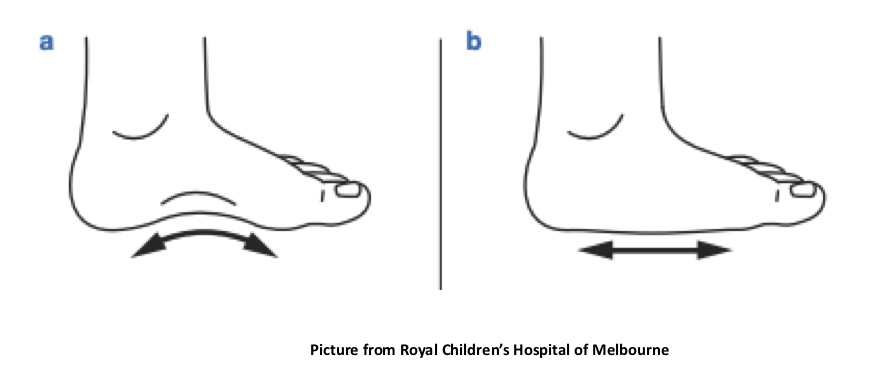Doctors’ Notes
BackFlat Feet
Having flat feet is a common condition that is usually painless and does not require any treatment.
What is Flat Foot?
Babies are born with flat feet due to a fat pad covering the arches of their feet. A foot arch is a mild curvature of the sole of the foot as shown in the image below.
 Most kids naturally develop an arch in their foot over the course of their childhood. Arches can be seen in most children by 6-10 years of age. However, up to 20% of children never develop an arch in their feet and therefore have “flat feet.” In children with “flat feet,” the entire sole of the foot touches the ground when standing.
Most kids naturally develop an arch in their foot over the course of their childhood. Arches can be seen in most children by 6-10 years of age. However, up to 20% of children never develop an arch in their feet and therefore have “flat feet.” In children with “flat feet,” the entire sole of the foot touches the ground when standing.
In most children with flat feet, the foot is flat when standing, but an arch can be seen when they stand on their tip-toes or sit with their feet dangling. This is known as a “flexible flat foot.”
A handful of children with flat feet have a “rigid flat foot,” which is when the foot is flat both on and off the ground. This can cause difficulty moving and rotating the foot. These children may need to be seen by a specialist.
Flat feet can run in the family, but in some children it can be caused by other illnesses, including diabetes, rheumatoid arthritis, foot/ankle injuries, or genetic conditions.
What Are the Signs & Symptoms?
Most children with flat feet will have no symptoms and can run, jump, play, and participate in sports without any limitation — even into adulthood.
Some children with flat feet can have foot or ankle pain with excessive walking, running, or jumping. Those with a rigid flat foot can have a stiff foot and have difficulty rotating their foot and ankle.
This condition can usually be diagnosed by one of our providers through an exam in the office. X-rays are generally not needed.
What Can I Do For Foot and Ankle Pain From Flat Feet?
If your child doesn’t have any symptoms, then no treatment is necessary. Most children will have no long-term problems into adulthood.
No treatments can create an arch or change the shape of your child’s foot. However, for children who have foot or ankle pain, several remedies may be helpful:
Well-Fitting Shoes
Make sure your child wears shoes that fit comfortably, have cushioned arch support, and a supportive heel. Running shoes should have built-in arch support. Minimize time in shoes without supports such as sandals and flip-flops
Arch Supports
Soft arch supports may be found over the counter and are often just as good as custom orthotics
Avoid Hard or Rigid Arch Supports
These can worsen the pain. Corrective shoes or ankle braces are also generally not needed
Stretches
Gentle stretches of the foot and ankle can sometimes be helpful
If your child’s pain persists despite the above measures or if your child has a stiff foot with limited range of motion, then consultation with a specialist may be helpful.
Dr. Nikita Roy has been a Kids Plus Provider since 2019.